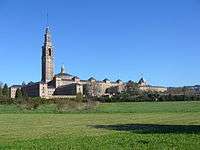Universidad Laboral de Gijón
| Universidad Laboral de Gijón | |
|---|---|
 | |
| General information | |
| Architectural style | Neo-Herrerian |
| Address |
Luis Moya Blanco, 261 33203 Gijón (Asturias) |
| Town or city | Gijón, Asturias |
| Country | Spain |
| Coordinates | 43°31′28.08″N 5°36′54.16″W / 43.5244667°N 5.6150444°W |
| Construction started | 1946 |
| Completed | 1955 |
| Renovated | 2001–2007 |
| Universidad Laboral de Gijón | |
|---|---|
| Location | Gijón, Spain |
| Area | 45.64 ha |
| Built | 1955 |
| Official name: Universidad Laboral de Gijón | |
| Type | Non-movable |
| Criteria | Monument |
| Designated | 19 May 2016 |
The Universidad Laboral de Gijón is located in Gijón (Asturias, Spain) specifically in the parish of Cabueñes.
History
Built between 1946 and 1955, it is the most important architectural work built in the 20th century in Asturias and is considered, with its 270,000 m2, the biggest building in Spain.[1]
On 19 May 2016 the Universidad Laboral was declared Bien de Interés Cultural.[2][3]
The building


The building is built with its back facing Gijón. Luis Moya designed it based on the Parthenon, with the aim of surrounding the building before entering to enjoy its full magnificence.
Door
The door is located in the main facade, an arch with a shaped tower. Above the arch is a shield with the eagle of Saint John and the yoke and arrows of the Catholic Monarchs with two angels holding it.
Courtyard
The courtyard is uncovered with an area of 150×150 m2. All of the building is structured around the courtyard.
Church
The church is the most spectacular building in the Universidad Laboral. With a surface area of 807 m2, it is the biggest church with an elliptical floor in the world.
Outside, there is a figure of the Virgin of Covadonga with Corinthian columns sustaining the statues of St. Joseph, St. Peter, St. Paul and St. Ignatius. Above them all, St. James on horse with two angels sustains the Victory Cross, the coat of arms of Asturias.
The church has a 2,300-ton dome. The height between the floor and the highest point of the dome is 32 m. In the construction of the church about 450,000 bricks were used. The floor is made entirely of marble and the benches, for more than one thousand people, of a special wood from Equatorial Guinea. The original benches were cut exclusively for this church and each was made in one piece. Today, the benches are not in the church.
The church is unconsecrated and has no Catholic icon. It is currently used to host art exhibitions.
Theater
The theater has a Hellenic style facade and similar dimensions to the Parthenon. Above the central pediment there is a big coat of arms of Spain following the model of 1945.
The capacity of the theater is about 1,500. It was the first totally air-conditioned theater, using an underground system of air distribution.
The frontispiece was decorated with a 120-m2 fresco of Enrique Segura. When the building was abandoned, it was damaged by humidity and was replaced by a big shell of wood to improve the acoustics.
Tower
With a height of 117 m, the tower is modeled after that of Giralda, the bell tower in the Cathedral of Seville. An elevator brings visitors to the balcony to enjoy sweeping views of Gijón.
The tower of the Universidad Laboral is the tallest building in Asturias and the tallest stone building in Spain.
Current uses
Several institutions are located in the main building, such as LABoral Centro de Arte y Creación Industrial, faculties of the University of Oviedo, the Drama High School of Asturias and the Professional Music School of Gijón. Laboral Ciudad de la Cultura was inaugurated in 2007.
In the rest of the lands bequeathed by the José Antonio Girón Foundation to the Universidad Laboral, other new facilities were created. In the Lloreda farm, a municipal golf course was created and in the Agronomic farm of Somió, the High School of the Universidad Laboral was built. The old convent of the Clarisas is now the headquarters of the Radiotelevisión del Principado de Asturias. The Hospital of Cabueñes, the municipal morgue, the Scienfic and Technologic Park and the Campus of Gijón, as part of the University of Oviedo, now occupy the former sporting grounds.
The world center of Research and development of the German multinational ThyssenKrupp is located In the northern wing, with a building of about 2,000 m2.
The Universidad Laboral has been used in several films, including those of the Spanish director José Luis Garci, La gran aventura de Mortadelo y Filemón and Fuga de Cerebros, which stood in for Oxford University.
References
- ↑ 55 años como vigía de Gijón; El Comercio, 13 October 2010 (Spanish)
- ↑ "La Universidad Laboral, Bien de Interés Cultural (BIC)" (in Spanish). La Nueva España. 19 May 2016. Retrieved 12 July 2016.
- ↑ "Decreto 19/2016, de 19 de mayo, por el que se declara bien de interés cultural, con la categoría de monumento, la Universidad Laboral de Gijón." (in Spanish). Boletín Oficial del Estado. 12 July 2016. Retrieved 12 July 2016.
External links
| Wikimedia Commons has media related to Universidad Laboral de Gijón. |
- Historic website (Spanish)
- Laboral Ciudad de la Cultura